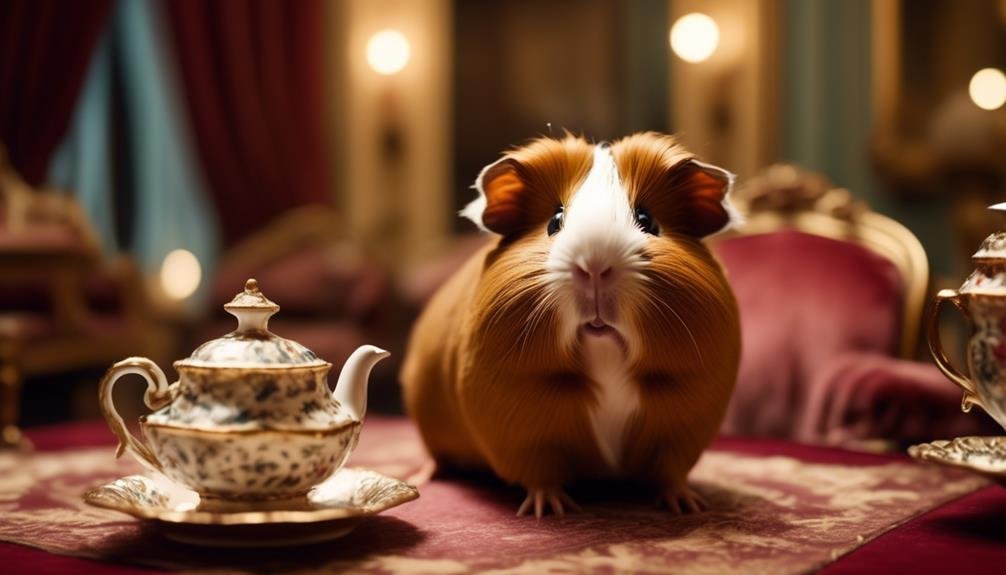
Victorian England's fascination with the unique Abyssinian guinea pig offers a captivating glimpse into the allure of this extraordinary breed.
Renowned for its exquisite coat adorned with swirls of hair known as rosettes, the Abyssinian captivated the hearts of many during the Victorian era.
However, there is more to this breed than just its striking appearance. From its ancient origins to its challenges in breeding, the Abyssinian guinea pig holds a tale that is both intriguing and informative.
Join me as we delve into the history, characteristics, and genetic concerns surrounding this remarkable creature, uncovering the secrets that made the Abyssinian a beloved fascination of Victorian England.
Key Takeaways
- The Abyssinian guinea pig has a long history dating back to ancient times and originated in the Incan civilization.
- Victorian England played a significant role in popularizing the Abyssinian guinea pig, particularly due to its captivating and unique coat featuring swirls of hair known as rosettes.
- Show quality Abyssinians are characterized by well-defined rosettes, perfect fur length, and a variety of colors and patterns, but breeding and grooming them can be challenging.
- Breeding Abyssinians requires attention to genetic concerns such as rosette symmetry, coat patterns, and the risks associated with the white gene, but responsible breeding practices prioritize the health and well-being of the guinea pigs.
History of the Abyssinian Guinea Pig
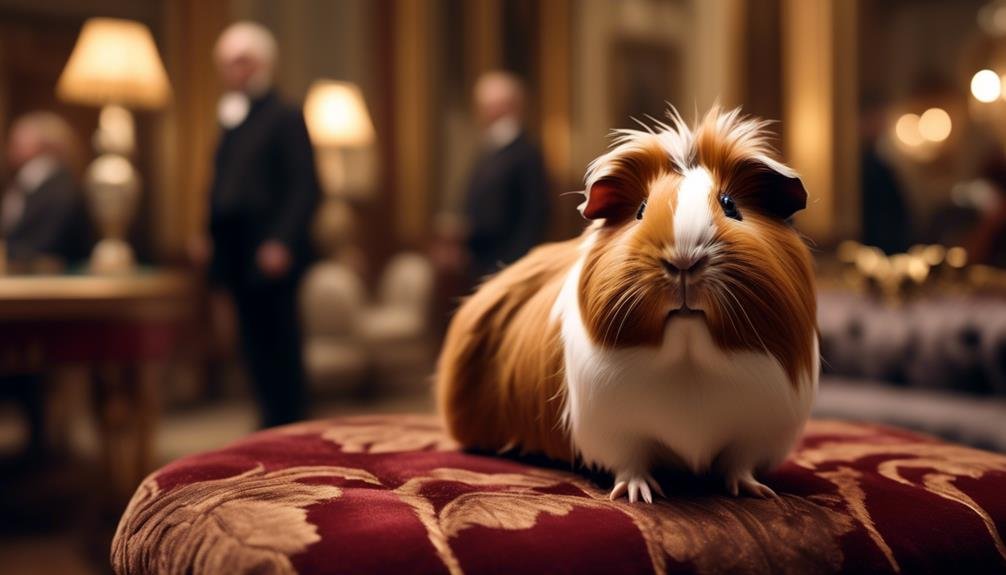
The history of the Abyssinian Guinea Pig dates back to ancient times, making it one of the oldest and most fascinating guinea pig breeds. Contrary to its name, the Abyssinian guinea pig did not originate in Ethiopia, but rather in the Incan civilization. However, it gained popularity in Victorian England for its unique coat.
This breed is considered an exhibition cavy and was highly sought after during that era. Victorian England was particularly fascinated by the Abyssinian's coat, which consists of swirls of hair known as rosettes. Show quality Abyssinians typically have 8-10 distinct rosettes, and their fur comes in various colors and patterns.
Breeding Abyssinians with ideal rosettes is a challenging task. Despite its long history, no specific health issues are associated with this breed.
Origin of the Abyssinian Breed
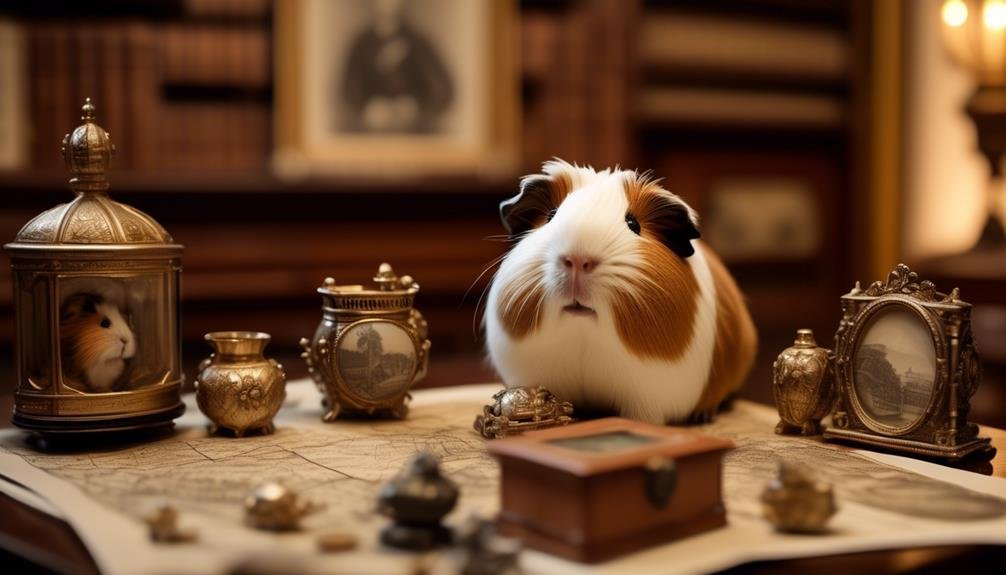
Contrary to its Ethiopian-sounding name, the Abyssinian guinea pig's origins can be traced back to the Incan civilization, making it one of the oldest and most intriguing breeds in history. Its unique lineage has fascinated guinea pig enthusiasts for centuries.
Here are some key points about the origin of the Abyssinian breed:
- Incan civilization: The Abyssinian guinea pig breed originated in the Incan civilization, showcasing its ancient roots.
- Victorian England: The breed gained popularity in Victorian England, where its distinctive coat, adorned with swirls of hair called rosettes, captivated the public.
- Exhibition cavy: The Abyssinian is considered an exhibition cavy, sought after for its distinctive appearance.
- Breeding challenges: Breeding Abyssinians with ideal rosettes is a challenging task, requiring careful selection to achieve the desired coat pattern.
- Color and pattern variations: Abyssinians come in a variety of fur colors and patterns, adding to their allure.
With its rich history and unique characteristics, the Abyssinian guinea pig continues to be a beloved breed among enthusiasts today.
Popularity in Victorian England
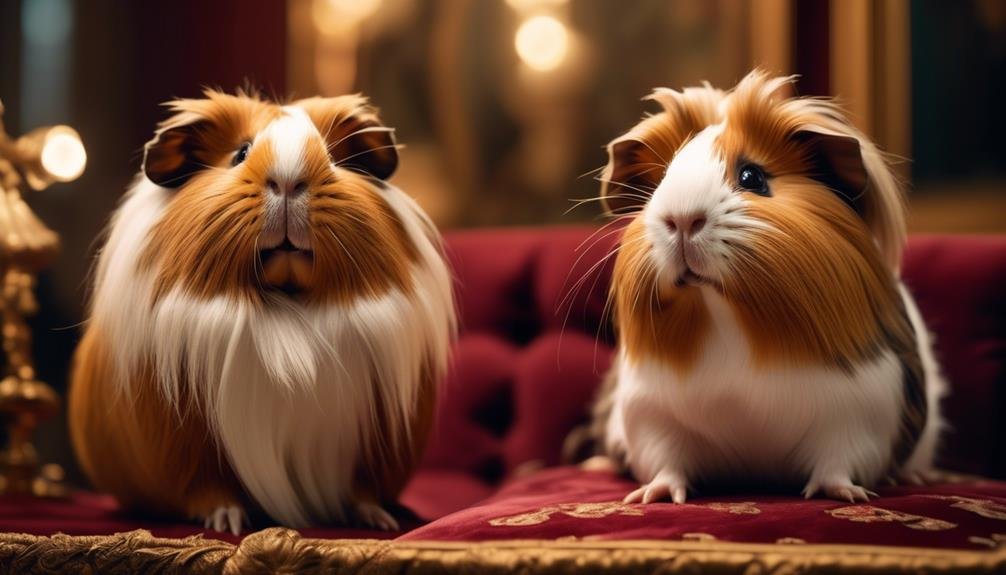
During the Victorian era, the Abyssinian guinea pig gained immense popularity in England due to its captivating and unique coat. Victorian England was captivated by the swirls of hair, known as rosettes, that adorned the Abyssinian's body. The hair, approximately 1.5 inches long, formed 8-10 distinct rosettes in show quality Abyssinians. These rosettes came in various colors and patterns, adding to the guinea pig's appeal.
Breeding Abyssinians with ideal rosettes proved to be a challenge, further intriguing Victorian breeders. To maintain the Abyssinian's distinctive coat, frequent brushing and special grooming were necessary. Despite these requirements, the popularity of the Abyssinian guinea pig continued to rise, making it a sought-after pet and exhibition cavy during the Victorian era in England.
Characteristics of the Abyssinian Coat
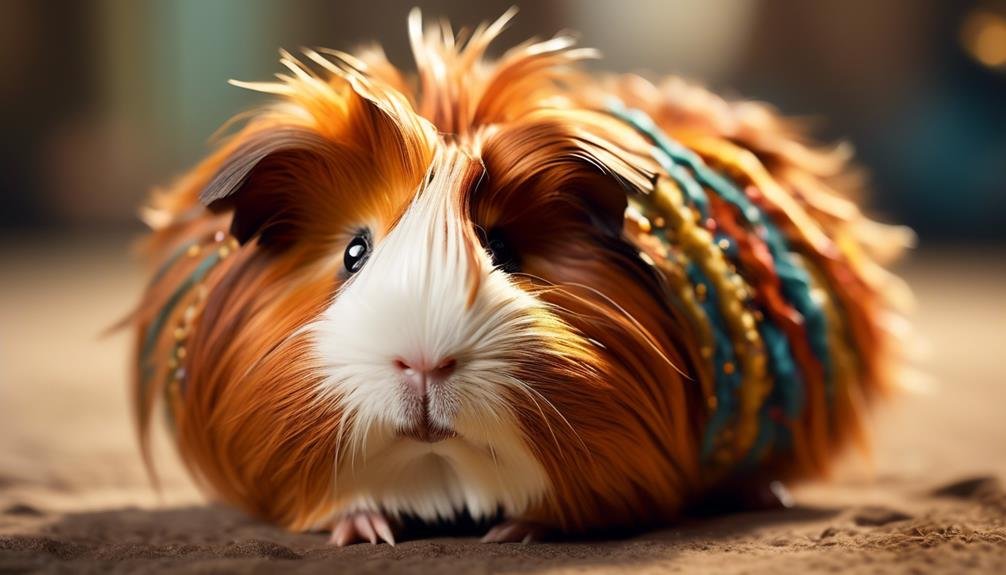
The Abyssinian guinea pig's coat is known for its unique and captivating features. Here are some characteristics of the Abyssinian coat:
- Swirls of hair called rosettes: The Abyssinian has a coat with distinct rosettes, which are swirls of hair. These rosettes give the guinea pig a textured and eye-catching appearance.
- Length of hair: The hair of an Abyssinian is approximately 1.5 inches long, providing a fluffy and soft texture.
- Number of rosettes: Show quality Abyssinians typically have 8-10 distinct rosettes, evenly distributed across their body.
- Variety of colors and patterns: The fur of Abyssinians comes in a wide range of colors and patterns, allowing for individuality and uniqueness.
- Challenges in breeding: Breeding Abyssinians with ideal rosettes can be challenging, as it requires careful selection and pairing to maintain the desired coat characteristics.
These characteristics contribute to the allure and popularity of the Abyssinian guinea pig's coat, making it a fascinating breed for guinea pig enthusiasts.
Unique Hair Swirls: Rosettes
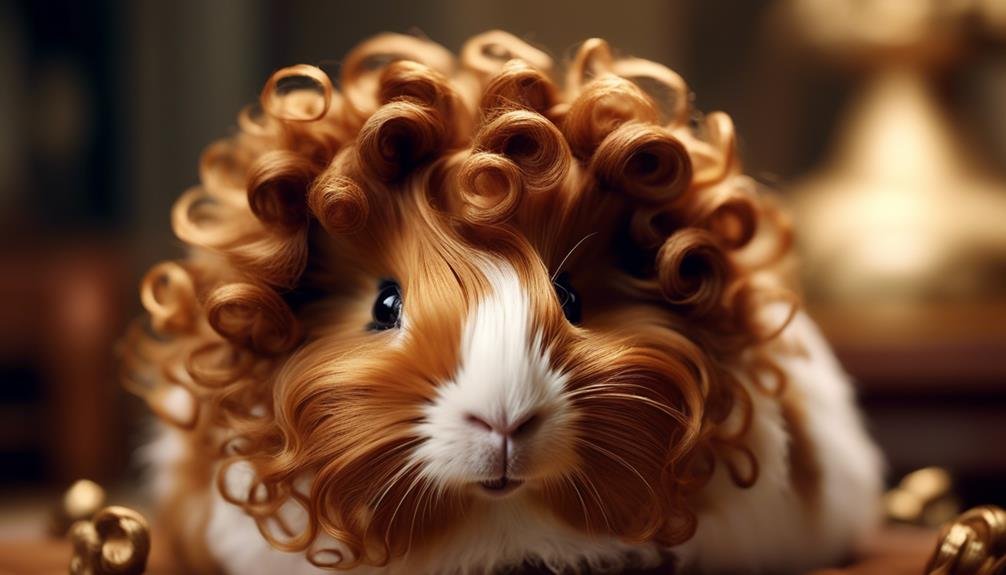
Moving on from discussing the characteristics of the Abyssinian coat, let us now focus our attention on the distinct feature that sets this breed apart: the unique hair swirls known as rosettes.
The Abyssinian guinea pig is renowned for its coat, which is adorned with approximately 1.5-inch long swirls of hair. Show quality Abyssinians typically exhibit 8-10 distinct rosettes, adding to their charm and appeal. These rosettes come in various colors and patterns, making each Abyssinian truly unique.
However, breeding Abyssinians with ideal rosettes can be a challenging task. It is important to note that frequent brushing is necessary to prevent tangling of the coat, and special grooming techniques may be required due to the unique nature of the rosettes.
Show Quality Abyssinians
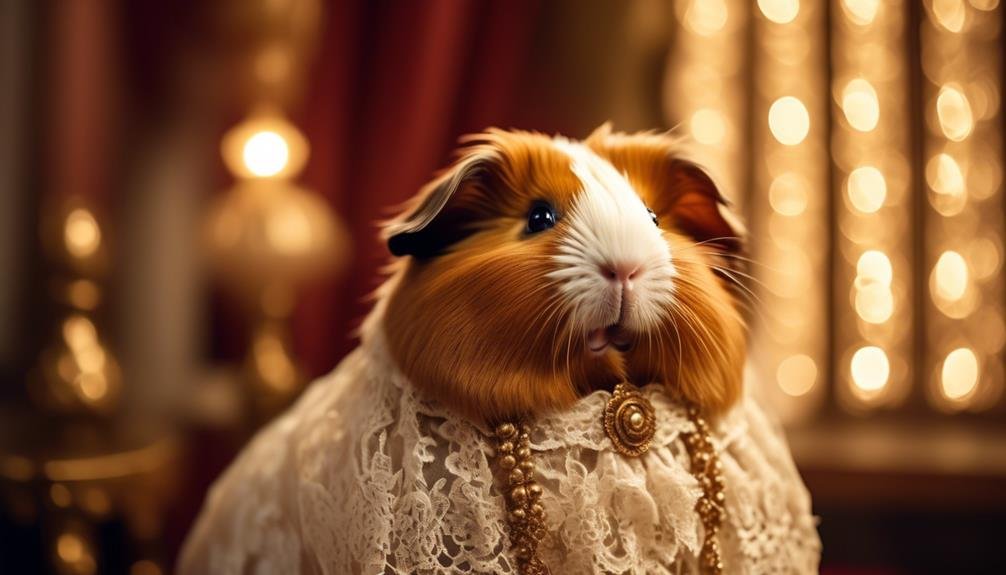
Abyssinians that meet the standards for exhibition are known as show quality guinea pigs. These guinea pigs possess the ideal characteristics that make them stand out in the show ring. Here are some key features of show quality Abyssinians:
- Well-defined rosettes: Show quality Abyssinians have 8-10 distinct rosettes, which are the signature swirls of hair on their coat.
- Perfect fur length: The hair of a show quality Abyssinian is approximately 1.5 inches long, giving them a fluffy and attractive appearance.
- Varied colors and patterns: Show quality Abyssinians come in a wide range of colors and patterns, adding to their visual appeal.
- Challenging breeding process: Breeding Abyssinians with ideal rosettes is a complex task that requires careful selection and breeding techniques.
- Attention to grooming: Show quality Abyssinians require special grooming to maintain the condition of their unique coat.
These show quality Abyssinians captivate audiences with their stunning appearance and impeccable breed standards.
Variety of Colors and Patterns
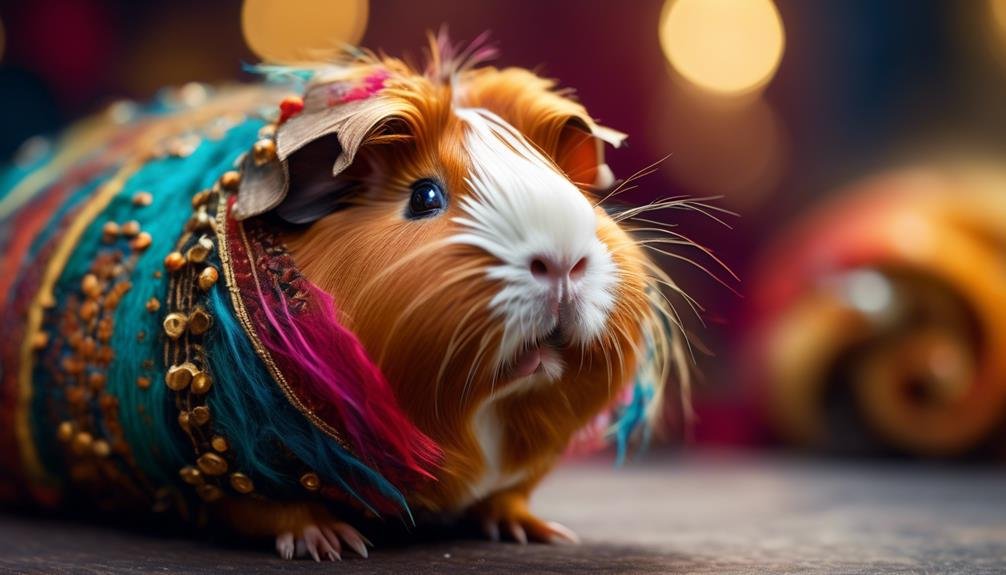
After discussing the characteristics of show quality Abyssinians, it is relevant to explore the diverse range of colors and patterns found in this captivating guinea pig breed.
The Abyssinian guinea pig comes in a variety of colors, including black, chocolate, white, cream, and lilac. These colors can be solid or combined with other patterns such as tortoiseshell, brindle, and dalmatian.
The patterns on the Abyssinian's coat are created by the unique arrangement of rosettes, which can vary in shape and size. Some Abyssinians may have more rosettes, while others may have fewer.
The combination of colors and patterns in the Abyssinian's coat adds to its charm and allure, making it a favorite among guinea pig enthusiasts.
Challenges in Breeding Abyssinians
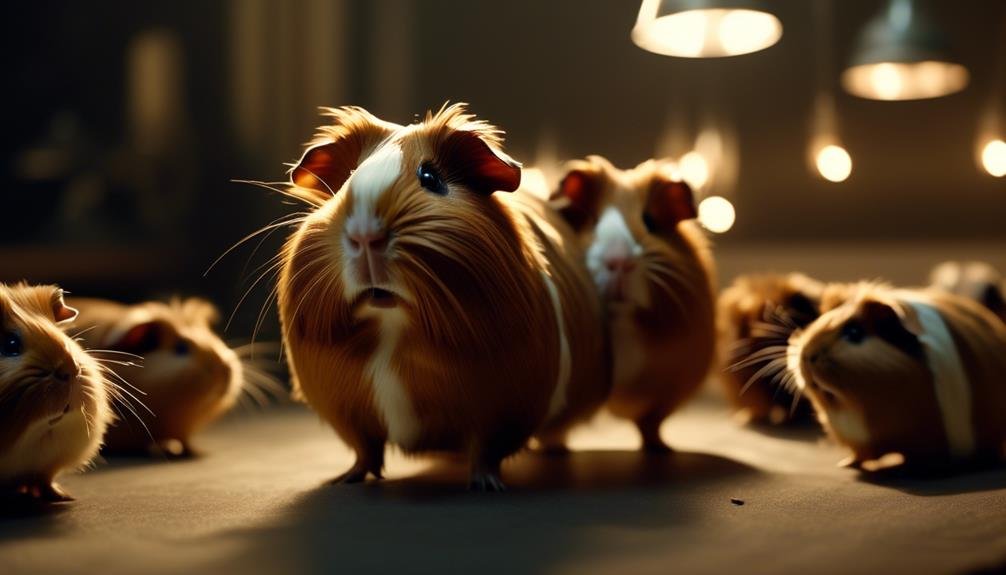
Breeding Abyssinians presents unique challenges due to the intricacies involved in achieving the ideal rosette formation in their coat. These challenges include:
- Genetic variability: Abyssinians have a wide range of coat patterns and colors, making it difficult to consistently produce offspring with the desired rosette formation.
- Rosette symmetry: Achieving symmetrical rosettes on both sides of the guinea pig's body requires careful breeding and selection of breeding pairs.
- Rosette size and shape: Breeders aim for rosettes that are evenly spaced, well-defined, and of the ideal size and shape, which can be challenging to achieve.
- Maintaining coat quality: The unique coat of Abyssinians requires regular grooming to prevent tangling and maintain its characteristic swirls.
- Health considerations: Breeding Abyssinians necessitates careful monitoring for any potential health issues associated with the breed to ensure the well-being of the offspring.
Health Care for Abyssinians
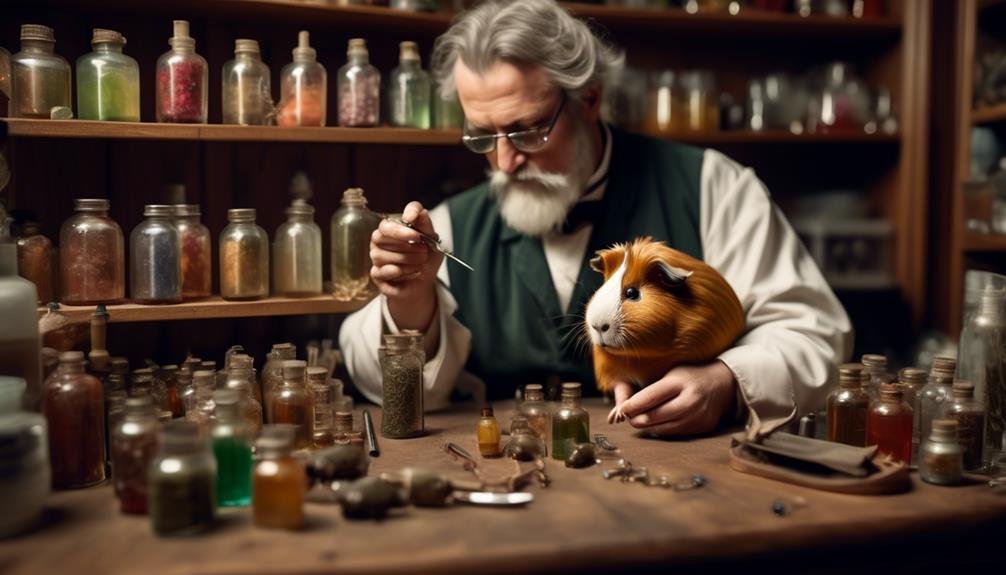
To ensure the well-being of Abyssinian guinea pigs, proper health care is essential. These unique creatures require regular grooming to maintain the health of their distinctive coat. Due to the swirls of hair called rosettes, frequent brushing is necessary to prevent tangling and matting. The special nature of their fur requires specific grooming techniques to keep it in optimal condition.
Fortunately, no specific health issues are associated with Abyssinians, but regular veterinary check-ups and monitoring of their general well-being are important. Additionally, it is advised to avoid breeding two roan Abyssinians as it can result in genetic problems and potential defects linked to the white gene.
Special Grooming Requirements
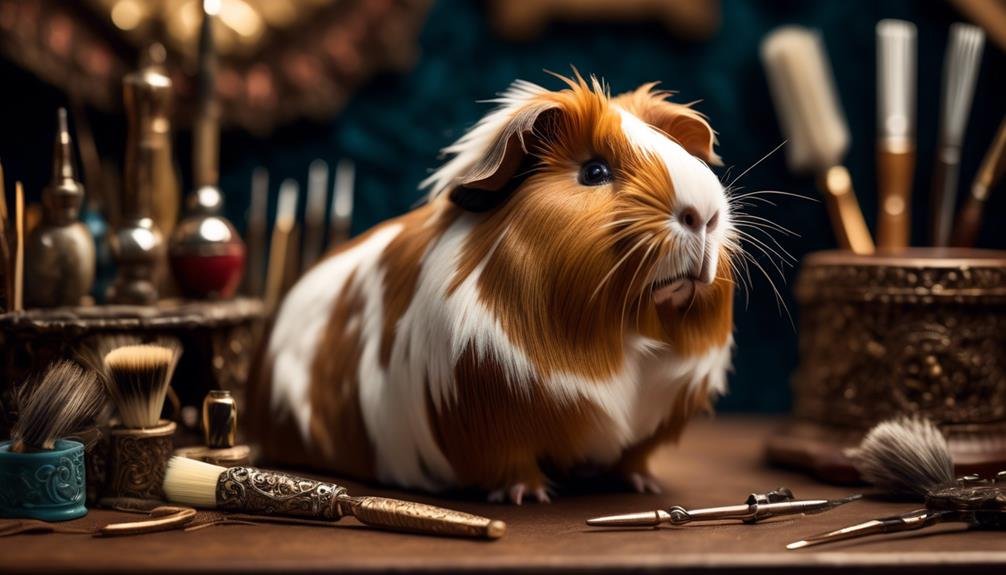
Properly caring for Abyssinian guinea pigs includes meeting their special grooming requirements to ensure the health and maintenance of their unique coat. These grooming requirements are essential for maintaining the distinctive appearance of Abyssinians.
Here are some important considerations for grooming Abyssinian guinea pigs:
- Regular brushing: Abyssinians need frequent brushing to prevent tangling and matting of their coat. It is recommended to brush them at least once a week.
- Gentle handling: Due to the delicate nature of their coat, Abyssinians should be handled with care to avoid damaging their rosettes.
- Bathing: Abyssinians do not require frequent bathing as it can strip their coat of natural oils. However, occasional baths may be necessary if their coat becomes soiled.
- Trimming: Regular trimming of the hair around their eyes and rear end is important to maintain cleanliness and prevent irritation.
- Diet: A balanced diet rich in essential nutrients is crucial for maintaining the health and appearance of their coat.
Genetic Concerns: Breeding Roan Abyssinians
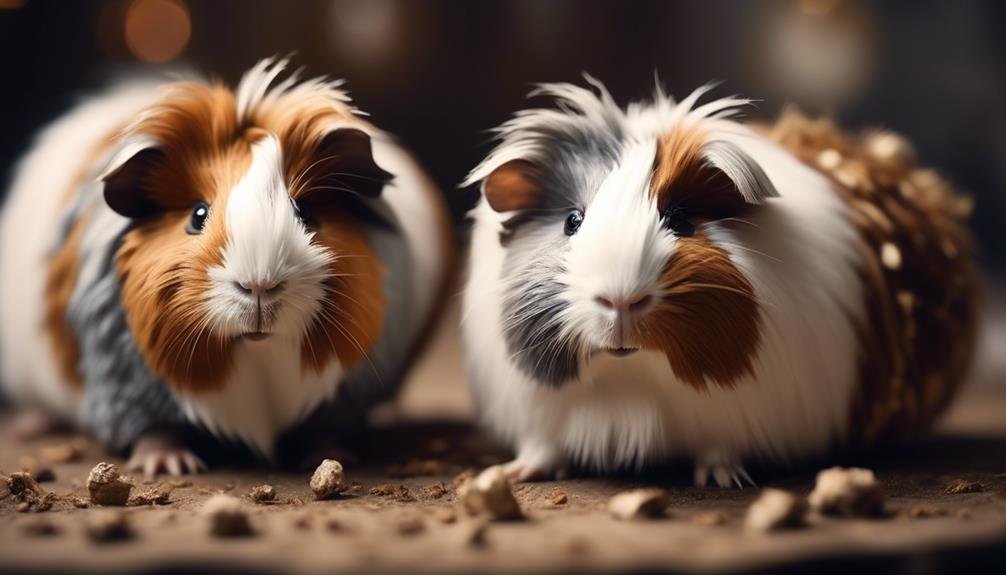
The breeding of Roan Abyssinian guinea pigs raises important genetic concerns. When two roan Abyssinians are bred together, there is a risk of producing offspring with defects associated with the white gene. While specific information about the roan coloration is not provided, it is important to note that potential lethal defects have been associated with black roan Abyssinians.
To mitigate these risks, it is advisable to breed roan Abyssinians with other colors. By introducing genetic diversity, the likelihood of producing healthy offspring is increased. Breeders should prioritize the health and well-being of the guinea pigs and make informed decisions to prevent any genetic issues.
Responsible breeding practices are necessary to maintain the overall health and vitality of the Abyssinian guinea pig breed.
Safe Breeding Practices With Roan Abyssinians
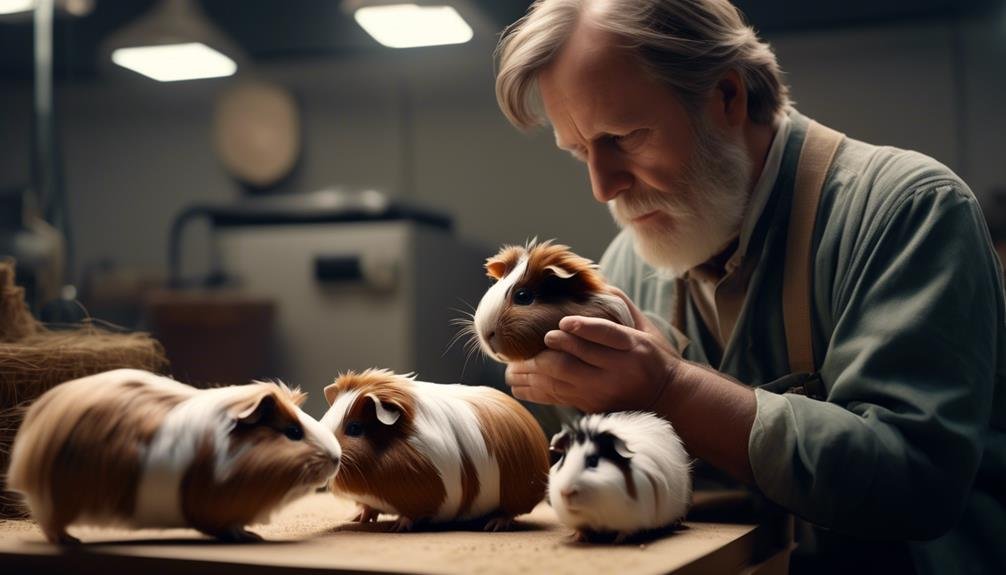
Breeding Roan Abyssinian guinea pigs requires careful consideration of genetic concerns, and implementing safe breeding practices is essential to ensure the health and well-being of the offspring. To breed Roan Abyssinians responsibly, it is recommended to follow these safe breeding practices:
- Select healthy breeding stock: Choose Roan Abyssinians that are free from any known genetic defects or health issues.
- Crossbreed with non-roan Abyssinians: Breeding a Roan Abyssinian with a guinea pig of a different color can help reduce the risk of genetic problems associated with the roan gene.
- Monitor offspring closely: Keep a close eye on the health and development of the offspring to identify any potential issues early on.
- Seek veterinary advice: Consult with a veterinarian experienced in guinea pig breeding to ensure you are taking the necessary precautions and providing proper care.
- Responsible breeding: Only breed Roan Abyssinians if you have the knowledge, resources, and time to properly care for the offspring and find suitable homes for them.
Lethal Defects in Black Roan Abyssinians
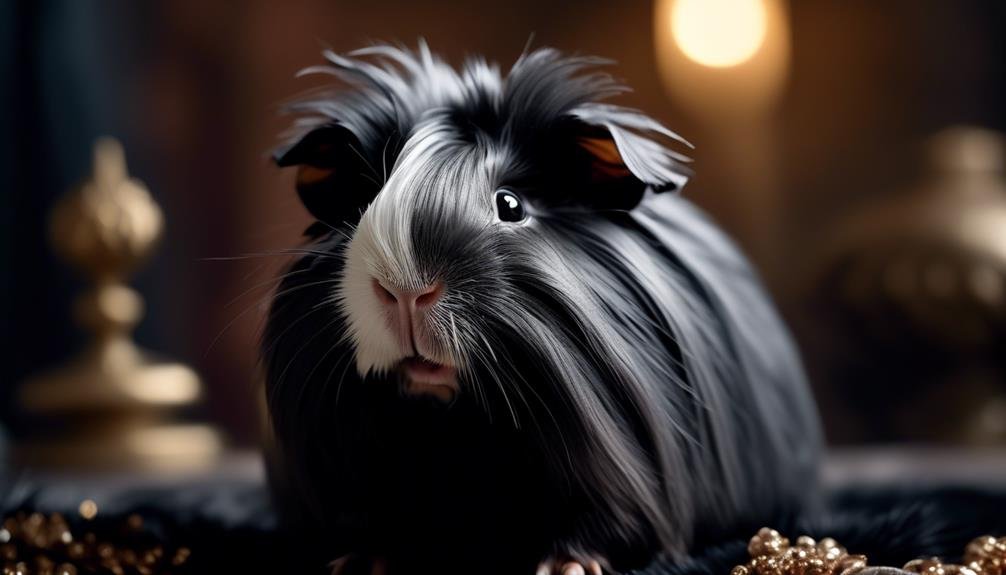
Lethal defects have been observed in black roan Abyssinian guinea pigs, necessitating careful consideration during breeding practices. When breeding two black roan Abyssinians, there is a risk of genetic problems linked to the white gene. Offspring may exhibit defects that can be detrimental to their health and survival.
It is important for breeders to be aware of these potential issues and take appropriate precautions to prevent the transmission of these lethal defects. However, it should be noted that roan Abyssinians of other colors can be safely bred without the same risk of genetic problems.
Therefore, it is advisable to avoid breeding black roan Abyssinians together to ensure the well-being of the offspring.
Frequently Asked Questions
What Are the Different Colors and Patterns That the Abyssinian Guinea Pig's Fur Can Come In?
The Abyssinian guinea pig's fur can come in various colors and patterns. It has a unique coat with swirls of hair called rosettes, which are approximately 1.5 inches long. Show quality Abyssinians have 8-10 distinct rosettes.
Are There Any Specific Health Issues That Abyssinian Guinea Pigs Are Prone To?
No specific health issues associated with Abyssinian guinea pigs have been mentioned. However, frequent brushing and special grooming are necessary to prevent tangling of their unique coat, which consists of swirls of hair called rosettes.
How Often Does the Abyssinian Guinea Pig's Coat Require Grooming?
The Abyssinian guinea pig's coat requires frequent grooming due to its unique nature. Special grooming techniques are necessary to prevent tangling of the hair. However, no specific information about the frequency of grooming was provided.
What Are the Potential Genetic Problems That Can Occur When Breeding Two Roan Abyssinians?
Breeding two roan Abyssinians can result in genetic problems, including defects linked to the white gene. However, roan Abyssinians can be safely bred with other colors. Black roan Abyssinians may have potential lethal defects.
Can Roan Abyssinians Be Safely Bred With Other Colors, Besides the Potential Genetic Problems?
Breeding roan Abyssinians with other colors is generally safe, except when breeding two roan Abyssinians together, which can result in genetic problems. No specific information is provided about the roan coloration and its potential effects on breeding.
What Makes Texel Guinea Pigs a Unique Pet Choice Compared to Abyssinian Guinea Pigs in Victorian England?
Texel guinea pigs are the ultimate pets due to their long, curly coats, making them a unique choice in Victorian England compared to Abyssinian guinea pigs. Their striking appearance and gentle nature made them highly sought after as pets, especially among the elite class during that time.
Conclusion
In conclusion, the Abyssinian guinea pig's unique coat and rich history have captivated Victorian England. With its distinct rosettes and a variety of colors and patterns, this breed gained immense popularity as an exhibition cavy.
However, breeding Abyssinians with ideal rosettes can be challenging, and careful selection is necessary to prevent genetic problems. Additionally, special grooming is required to prevent tangling of their fur.
The Abyssinian guinea pig continues to be an enduring symbol of fascination and admiration.




